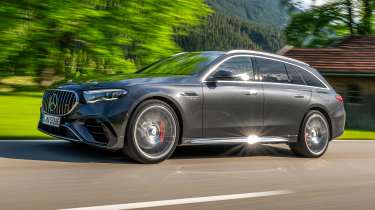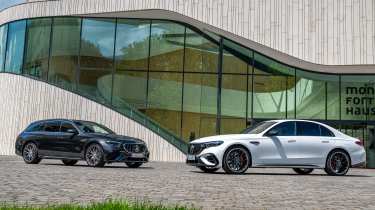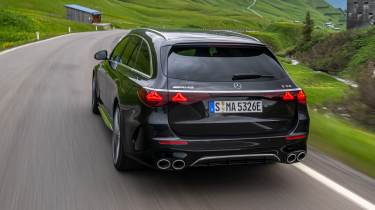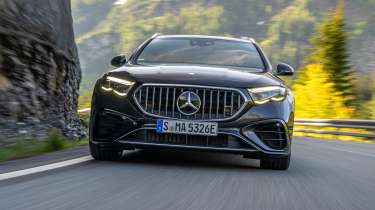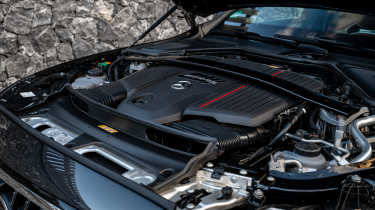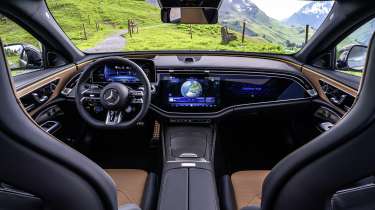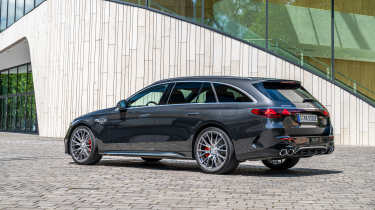Mercedes-AMG E53 Hybrid 4Matic+ 2024 review – AMG’s first long-distance hybrid tested
There won’t be a new E63 for the foreseeable but there is a new E53 range-topper – and it’s AMG’s first long-distance PHEV
Mercedes-AMG is not planning to build a new E63. So, for the foreseeable future, this is the most potent Mercedes E-class you can get: the new Mercedes-AMG E53 performance hybrid, available as either a saloon or estate.
It’s AMG’s first long-range hybrid, a plug-in with a total power output of 577bhp (more in ‘Race Start’ mode) and a 59-mile all-electric driving range. While a fast car, it’s also an easy-going, refined one, based on our first experience of it here on its international launch. Read on for the full first drive review.
> Mercedes-AMG CLE 53 4MATIC+ Coupé 2024 review – 443bhp six-cylinder hybrid targets BMW M440i
Engine, gearbox and technical highlights
The E53 combines a 443bhp 3-litre straight-six with a 120kW electric motor, integrated into the transmission between the engine and gearbox (a nine-speed auto). Total system output from the engine and motor working together is 577bhp and 553lb ft. The combustion engine is essentially the same as that in the Mercedes-AMG CLE 53, barring a few tweaks here and there, but the big difference is that the E53 is a plug-in hybrid with a considerable electric-only range, whereas the CLE 53 hybrid isn’t a plug-in.
Technically, the E53 is capable of a higher-still power output than its 577bhp system total: Race Start mode – available as an option with the AMG Performance package and AMG Driver’s Package – gives you a temporary 612bhp total output, albeit only momentarily from a standing start.
More reviews
In-depth reviews
Reviews
- Mercedes-Benz E55 AMG (W211, 2003 - 2006): review, specs and buying guide
- Mercedes E-class 2024 review – plug-in hybrid E300e tested
- Mercedes-AMG E53 2021 review – brimming with tech, but missing the charisma of an M550i
- Mercedes E-class 2020 review – new E450 a smooth operator
- New Mercedes-Benz E-class review
- Mercedes E400d AMG-Line estate review
Both the motor and engine power all four wheels, and in theory the E53 features a ‘fully variable’ torque split via an electromechanical clutch, although in practice, a certain amount of torque is always sent to the front wheels, for the purpose of torque vectoring without delay. A certain amount of charge in the battery is always set aside by the powertrain management software for this purpose.
An electronically controlled limited-slip differential can be fitted at the rear as an option (also part of the AMG Performance pack, more on which later), while the front diff is open but assisted by torque vectoring.
The 400V, 28.6kWh battery is located under the boot floor, meaning a slightly smaller ultimate boot capacity than other E-class variants, but it’s still a long, comparatively practical boot space, with split folding rear seats. While 26.8kWh is the gross capacity, everyday usable capacity is 21.6kWh – partly because the aforementioned need to set aside a certain amount of charge for performance and torque vectoring. All UK cars get the 60kW DC fast-charger system as standard (models in Germany have an 11kW AC charger as standard, with the 60kW kit an option).
The E53 can travel at 87mph powered by its electric motor alone, and a quoted 59-mile range means plenty of average users’ average journeys can theoretically be completed purely in electric ‘EL’ mode. That’s the default setting when you first switch the car on, and the E53 has several further settings, all selected via the little rotary switch mounted to the steering wheel: Comfort, Sport, Sport + and Battery Hold to retain the battery’s current state of charge to deployed later, when you reach a city, for example.
In electric mode, there are also three different regenerative braking modes which can be toggled by the driver: a heavy regen mode, akin to one-pedal driving; an auto setting, where the amount of regen is continually altered on the fly; and a minimal recuperation mode for less abrupt deceleration.
The E53’s plug-in hybrid powertrain is also fitted to the Mercedes-AMG GLE 53 SUV model, although that car won’t be sold in the UK.
Performance and 0-62mph time
The hybrid powertrain makes this a heavy car. The saloon weighs 2390kg, and the estate 2435kg. Nevertheless, the saloon takes 3.8sec to get from 0-62mph, with the optional Race Start system (or 4sec without). The slightly heavier estate takes 3.9sec and 4.1sec with/without the Race Start system.
Top speed is electronically limited to 174mph for the saloon (with the optional AMG Driver’s Package; otherwise it’s limited to 155mph, as is the estate). The E53 estate’s top speed is 171mph with the option pack.
As a default, unless you change the drive mode before driving off, the E53 pulls away using its electric motor only. After all, it can deliver its maximum torque of 354lb ft from effectively 0rpm. If you need more power, or the battery’s running low, it automatically – and smoothly, it must be said – brings the engine into play and switches to the Comfort drive mode.
When the engine is in play, its power delivery is nice and smooth, and the E53 is a pleasantly, if undramatically, swift car to drive. There’s not much drama to the engine’s delivery, with no frantic rush to the top end, but it is flexible and refined. You can artificially enhance the sound in the option menus, but it sounds at its best – and most like a classical straight-six – when left to its natural sound. It’s at its enhanced noisiest in Sport+ mode, but you can toggle the sound off, via the touchscreen or configurable shortcuts on the wheel, and save your preference in Individual mode. Under heavier acceleration, the exhausts make that slightly flatulent (and slightly contrived) sound on upshifts that’s a hallmark of cars such as these.
Given the considerable amount of torque, and the interplay between motor and engine, the E53 doesn’t always allow manual downshifts as freely as you might expect on the paddles, and you sometimes need to let the revs drop a little lower than feels natural before you call on a lower gear, but shifts from the nine-speed ’box are smooth and swift.
Refinement is very good: this is a very quiet car at a cruise, with a little road noise from the wide tyres but impressively well suppressed wind noise and powertrain noise.
Ride and handling
The E53 employs steel springs and Bilstein adaptive two-valve dampers, with three different selectable modes. The damping is impressive: it’s certainly firm, as you’d expect from a performance car, but it’s high-quality in the way it controls the body’s movements and even in its firmest Sport+ setting, the E53 is a comfortable car on most surfaces. That said, despite the occasional rough section, the roads on our German and Austrian test route were mostly very much on the smooth side. The E53 copes well with diagonal inputs through the car at higher speeds, for example crossing a ridge in the road surface during cornering.
Our route took in a mix of autobahn and mountain roads, with occasional urban sections. Rear-wheel steering is standard, and boosts the E53’s agility considerably. Below 62mph, the rear wheels turn in the opposite direction to the fronts for manoeuvrability at parking speeds or agility on the move, and above 62mph they turn in the same direction as the fronts for stability. You can definitely feel the system in operation, and it’s not as unobtrusive as in some cars, but it soon feels relatively natural and works well.
At higher speeds on the autobahn (at one point we reached more than 160mph in the saloon), you can feel a bit of lift at the front, but that’s not unusual for a car like this and overall stability is confidence-inspiring. Less so the chunky steering wheel, which makes it difficult to fit your hands around perfectly (it’s the same wheel fitted to other AMG modes such as the C63, SL and AMG GT, with frustrating touch-sensitive surfaces on the spokes to control various functions). That exacerbates the slightly numb-feeling steering, which is not particularly communicative. It is very well insulated from kickback and cambers, however, and it’s very accurate – it’s quite a fast steering set-up, and you don’t need much lock for tight corners (particularly at low speeds, with the rear-steer in action). That can feel a bit odd at first, but you quickly get used to it, and the E53 does feel a nimble car that’s keen to change direction, despite its heavy kerb weight. It feels lighter than it really is; a little like the AMG GT, in fact.
The brakes blend regular friction braking and motor regen, and do feel odd at times as a result. The E53 uses a vacuum-independent electromechanical brake booster to combine the regen and hydraulic braking. It varies the braking power of the hydraulic system on the fly, the aim being consistent brake pedal pressure from the driver with the ratio of hydraulic braking and motor braking being adjusted behind the scenes without affecting the feel through the pedal. Pedal feel is certainly less vague than some hybrids and the E53 stopped well during our test, but you don’t quite have the total consistency and feedback you get from a traditional pure friction brake system.
Despite the difference in weight between the saloon and estate, they feel practically identical to drive. And they are effectively identical mechanically, just with a few very minor changes to spring rates and damper calibration for the estate.
MPG and running costs
Plug-in hybrid fuel economy is always open to conjecture, and highly dependent on use scenarios, but Mercedes-AMG’s official fuel consumption figures with the battery discharged on a combined route (urban and extra-urban) are 29.7-32.8mpg.
Interior and tech
Interior fit and finish felt very good in the cars we drove on the launch – more so than other Mercedes models we’ve tested of late. The test cars were equipped with the ‘MBUX super screen’ option, with a giant central touchscreen alongside the digital instrument panel behind the wheel and a third screen for the front-seat passenger to play with. The E53 gets various AMG-specific displays, hybrid-related extras such as a charging menu, battery status and so on.
There are multiple seat options, and our test cars were fitted with the optional AMG Performance seats, with a racerish shape and perforated man-made leather upholstery. They look great, and felt great on a long journey too, with support in all the right places for our tall-ish testers. There are different steering wheel options too, with leather standard and a carbon/microfibre combo an option.
Design
The E53 is a bit wider than a normal E-class, with wider tracks front and rear and much wider wheels: 265mm wheels at the front. There are totally different suspension kinematics compared with a regular E-class for this AMG version.
Underbody stiffness is increased too, and there’s a strut brace between the front suspension turrets. There are additional measures beneath the engine to alter the front load paths and stiffer mounting solutions for the rear suspension too, for greater precision.
In terms of styling versus the standard car, the AMG-specific grille is illuminated as an option and there’s the AMG crest on the bonnet in place of the regular Mercedes emblem. The front apron is unique to the AMG too, with bigger intakes, and at the rear there’s a diffuser design and different exhaust outlets. The saloon gets a lip spoiler on its bootlid.
Different Night Package options swap the usual chrome for black trim. 21-inch forged alloy wheels are standard in the UK. Red borders to the E53 badge on the bootlid identify this as a plug-in AMG, as they do on the C63.
Price and rivals
The Mercedes-AMG E53 is not a cheap car. At the time of writing (June 2024) it starts at £90,860 for the saloon and £93,102 for the estate, with UK deliveries scheduled before the end of 2024.
There are two trim levels at launch in the UK – Premium and Night Edition Premium Plus – plus the limited-run Edition 1 spec. The AMG Performance Package, as fitted to the cars tested here, costs £7495 and bundles together options including:
- The Dynamics Plus package: bigger brakes (390mm front discs with six-piston calipers, compared with the 370mm four-pots as standard, and red calipers), active engine mounts and an electronically controlled limited-slip diff at the rear.
- The AMG Driver’s package, including the top speed increase
- The AMG Performance seats and steering wheel trim
- The ‘Night Package II,�� i.e. a dark grille and other black exterior trim bits
- The Race Start function
The package is available for both the saloon and estate in Night Edition Premium Plus trim, and priced the same for both. It’s standard on the Edition 1.
I enjoyed driving the E53 very much. It’s an excellent long-distance car, with impressive damping and a good level of nimbleness considering its size and weight. Its weak point is that it’s not a very dramatic or memorable car; not a car in which you’d remember a drive vividly after the fact, or plan a driving expedition in. A BMW M3 saloon or M3 Touring is similarly priced yet hugely more exciting and enjoyable to drive – albeit a smaller car; the upcoming M5 will be a more comparable rival in terms of size, if perhaps not price or performance. Likewise the Audi RS6 is a more evocative, exciting car, albeit a good deal more expensive than the E53 Estate.
The E53’s comparative lack of drama could be a strength for some buyers, however. If you want a refined, comfortable, swift and posh-feeling performance saloon or estate, you may find there’s plenty to enjoy here.
